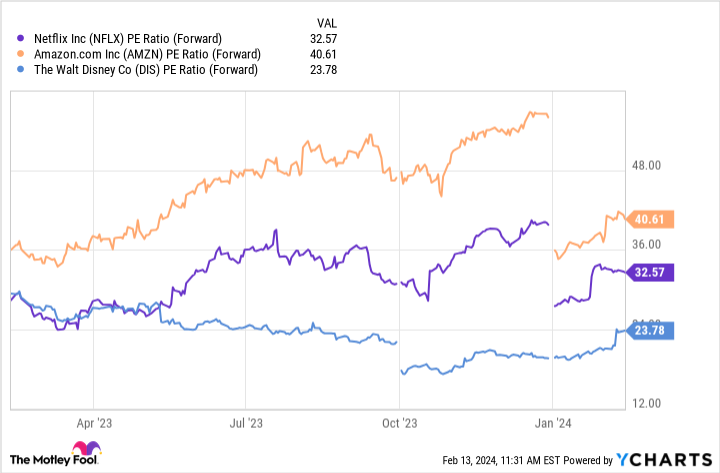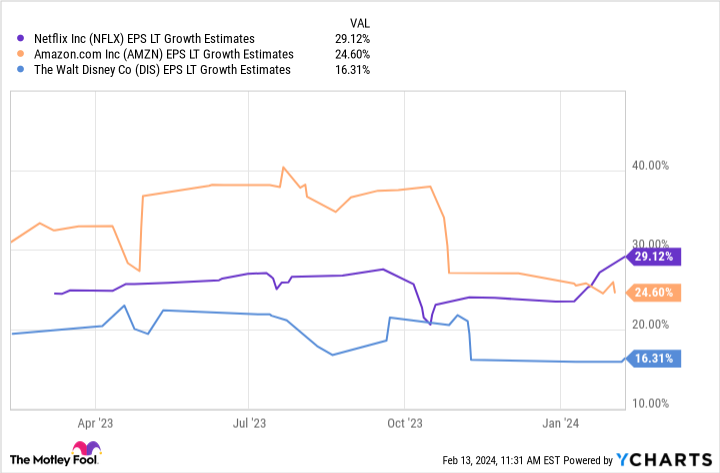U.S. consumers are in the middle of a tremendous shift in how they enjoy video media. The days of traditional cable television are numbered as more people opt to stream directly from the companies that own the media they crave.
The Motley Fool did a study on the streaming industry, surveying 2,000 Americans to find out what the future might hold for the industry and the stocks impacted by the latest trends. This first-hand information can help investors position their portfolios based on the potential long-term streaming winners.
Here are the top three streaming services by subscriber count, and which streaming stock might generate the best investment returns moving forward.
Streaming in America is a three-horse race
Understandably, media companies broadly understand the trend toward streaming, and this has created a crowded space with everyone rushing to get their streaming service to the market in recent years.
In all, 10 services were listed in this survey, while others were left out, like FuboTV, a streaming-based live TV product. But looking at the data, these three dominate the field:
First Place: Netflix
Netflix (NFLX -1.60%) benefited as the first mover in streaming, evolving from mail-in DVDs to digital content in 2007. Today, it’s the industry’s biggest service, with over 260 paying subscribers worldwide. The company initially leaned on licensing third-party content, but wisely spent years building up original programming to prepare for a time when media companies would hoard their intellectual content for their competing services.
Second Place: Walt Disney
Media giant Walt Disney (DIS -0.76%) didn’t go all-out on streaming until late 2019 when it launched Disney+. However, the company’s unmatched content portfolio has catapulted Disney to near the top. It operates a trio of services, including Disney+ (150 million subscribers), ESPN+ (26 million), and Hulu (48.5 million). That gives Disney a blend of content, sports, and live TV offerings.
Third Place: Amazon
Big tech company Amazon (AMZN -0.17%) has made significant inroads by tying its streaming service into its Amazon Prime membership, which gives customers perks for online shopping. Amazon has over 200 million subscribers via Prime, and the company has invested in its streaming offerings by acquiring MGM for $8.5 billion in 2022, giving it ownership of thousands of television shows and movies. It also jumped into live sports, purchasing broadcasting rights for the National Football League’s (NFL) Thursday Night Football games.
The next closest streaming service, HBO Max, has a solid 94 million users, but it’s still less than half of third-place Amazon, and the drop off only continues as you move down from the top 10.
How consumers might impact the stocks
It’s looking increasingly likely like streaming is a winner-takes-most type of industry, at least based on what consumers told The Motley Fool. Approximately 62% of those surveyed believe there are too many streaming options, and over a third of respondents have actively reduced their number of streaming services since last year.
Streaming’s original appeal was that desired content was easily accessible, and cutting the cord would save money versus cable. But that’s changed a bit. Media companies are pulling back their best content, locking it behind their respective streaming services. That means your favorite movies or shows are spread across different services, which hurts the consumer experience.
Interestingly, streaming usage peaks in the summer and drops over the holidays. The reason? That’s when live sports and holiday programming peak. The absence of these, especially live sports, remains a weakness for most streaming platforms.
Image source: Getty Images
Live sports are still a big draw for viewers, meaning that winning broadcast rights to live sports could be a long-term advantage as companies fight for streaming market share. The NFL dominates U.S. households. According to Nielsen, 93 of the top 100 most-watched TV programs in 2023 were NFL games.
Amazon (Thursday Night Football) and Disney (Monday Night Football) both own broadcasting rights for NFL games, leaving Netflix on the outside looking in. Netflix had its first live event, a special Golf Cup, in late November 2023. The evolution of live sports could play a big role in streaming’s future.
Which stock is the best buy today?
It’s tough to knock any of these three companies. One is the market leader in streaming, while the other two have complementary businesses outside of streaming that give investors additional upside.
Deciding a winner may come down to which stock currently offers the best value and expected growth.
NFLX PE Ratio (Forward) data by YCharts
The companies’ forward P/E ratios shows that Disney is currently the cheapest at about 24 times earnings, followed by Netflix at 33, then Amazon at 41. Using consensus long-term analyst estimates, Netflix is projected to grow earnings the fastest, followed by Amazon and Disney.
NFLX EPS LT Growth Estimates data by YCharts
To make sense of this, I like using the PEG ratio, a favorite metric of famed investor Peter Lynch. The ratio shows how much you pay for a company’s future growth. Based on this, Netflix’s PEG ratio of 1.1 is the most attractive for its prospective growth, followed by Disney’s 1.4, then Amazon’s 1.6.
Long-term investors should look for how Netflix will expand its content library in the future. Adding notable live sports could lock in its substantial market share. For now, its massive audience, attractive valuation, and growth prospects make a solid argument that it’s the streaming stock to own.





